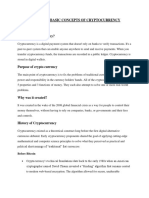0% found this document useful (0 votes)
12 views18 pagesModule 5
Module 5 discusses the stakeholders involved in cryptocurrency regulation, including government bodies, financial institutions, and users, highlighting their roles in shaping the crypto landscape. It also covers the roots of Bitcoin, its features, transaction processes, and the benefits and drawbacks of using Bitcoin as a decentralized currency. Additionally, it addresses the legal challenges faced by cryptocurrencies, particularly in terms of regulatory classification and the uncertain legal status in various jurisdictions.
Uploaded by
THEJASHWINI MCopyright
© © All Rights Reserved
We take content rights seriously. If you suspect this is your content, claim it here.
Available Formats
Download as DOCX, PDF, TXT or read online on Scribd
0% found this document useful (0 votes)
12 views18 pagesModule 5
Module 5 discusses the stakeholders involved in cryptocurrency regulation, including government bodies, financial institutions, and users, highlighting their roles in shaping the crypto landscape. It also covers the roots of Bitcoin, its features, transaction processes, and the benefits and drawbacks of using Bitcoin as a decentralized currency. Additionally, it addresses the legal challenges faced by cryptocurrencies, particularly in terms of regulatory classification and the uncertain legal status in various jurisdictions.
Uploaded by
THEJASHWINI MCopyright
© © All Rights Reserved
We take content rights seriously. If you suspect this is your content, claim it here.
Available Formats
Download as DOCX, PDF, TXT or read online on Scribd
/ 18























































































